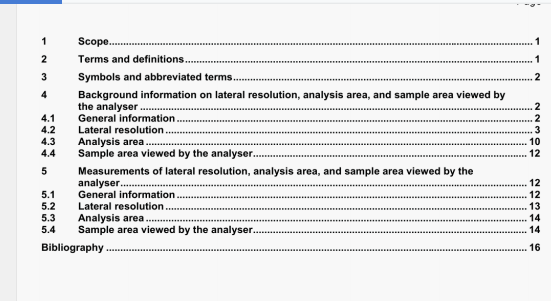AS ISO 19319 pdf download – Surface chemical analysis—-Augurelectron spectroscopy and X-rayphotoelectron spectroscopy一Determination of lateral resolution,analysis area and sample area viewed by the analyser.
Figure 1 also indicates an XPS configuration ii which the incident X-ray beam is focused to a spot on the sample surface. With a conventional X-ray source and a bent-aystal focuslig X-ray monochromator. the FWHM of the focused spot can be less than 10pm. Wh a synchrotron source of X-rays and a zone-plate, the FWHM of the focused spot can be less than 100 nm [11). The lateral resolution is determined by the FWHM of the focused spot. The experimental configurations for AES and XPS In Figure 1 are thus similar in that an incident beam is focused to a smal area on the sample surface Lateral variations of surface composition can thus be detected as the beam Is positioned on chfferent regions of interest. Is linearty scanned across a selected rewon. or is rastered to obaln information from a selected area. If the incident beam in Figure 1 is not normally incident on the sample surface, the beam profile will be elliptical instead of circular. In such cases. the lateral resolution will be given by the FHWM & the beani profile in two orthogonal rections (parallel and perpendicular to the plane of incidence)
Figure 2a) dlustrates an XPS configuration In which the electron energy analyser is part of an electron-optical configuration that views a selected singie smal area on the sample surface, The lateral resolution for this configuration depends on the electron-optical des@’i and can be less than 10 pm. Figure 2b) shows an XPS configuration in which the electron-optical system produces an image of a selected region of the surface. In this mode, different pixels of the image correspond to particular regions of the surface; information from muttçle points on the surface can be recorded io parallel. Figures 2a) and 2b) are sflar in that the regions of interest are selected by the electron-optical system. Lateral variations of surface composition can be detected. In principle, by mechanically moving the sample with respect to the analyser or. usually, by ustment of the electron-optical system to select the particular regions of interest on the sample surface from which photoelectrons are detected. As for Figure 1. photoelectron signals can be obtained from a selected region. from multiple regions along a line, or from multiple regions within a selected area,
Figure 3 shows a simpler XPS configuration In which the sample Is irradeated by X-rays from a nearby X-ray source and photoelectrons are detected as in Figure 2 from an area defined by the electron-optical properties of the analyser. Unlike the configurations of Figure 2. however, the instruments represented by Figure 3 were not designed to detect lateral vanatlons of surface composition except by movement of the sample with respect to the analyser. In this way, a lateral resolution of about 0.1 mm to 1 mm could be achieved.
Figure 7 shows a plot of !/i, from equation (5) as a function of rmex for the same parameter values selected for Figure 4. As expected, the intensity distribution In Figure 7 consists of two regions. Two-thirds of the total intensity is due to Auger electrons created by the primary beam while the remaining one-third is due to backscattered electrons. Approximately 28% of the total intensity comes from an area of radius 10 nm (the value of o, in this example), about 59% from an area of radius 20 nm, and about 66% from an area of radius 30 nm. The remaining intensity comes from a much larger area, with 90% from an area of radius about 310 nm, 95% from an area of radius about 390 nm, and 99% from an area of radius about 530 nm. Thus, while the lateral resolution ‘(50) is about 15 nm for this example, about two-thirds of the total Auger intensity comes from an area of radius 30 nm (double the lateral resolution) while 95% of the total intensity comes from an area of radius 390 nm (26 times the lateral resolution). The intensity from this larger area needs to be considered in interpretations of line scans and of poinr analyses (with the incident beam at a fixed location on the sample surface). In general. the analysis area will depend on the relevant material parameters (u and R) and on the particular percentage chosen in the operational definition for the analysis area (percentages of 90%, 95% and 99% of the total Auger intensity were used as examples here). It should also be emphasised that equation (1) is only expected to be a useful guide when the primary beam is normally incident on the sample surface. For other angles of incidence, analytical expressions [12] can be utilised or Monte Carlo simulations [15-17J can be performed to determine the analysis area. Monte Carlo calculations would be required if the sample of interest consisted of materials with significantly different values of o and R [17]. Finally, the Gaussian expression for the incident-beam profile in equation (1) may not be realistic for some instruments [(2].
AS ISO 19319 pdf download – Surface chemical analysis—-Augurelectron spectroscopy and X-rayphotoelectron spectroscopy一Determination of lateral resolution,analysis area and sample area viewed by the analyser
